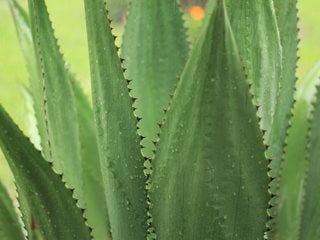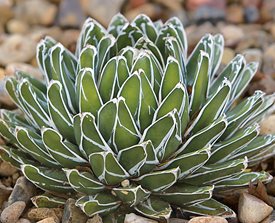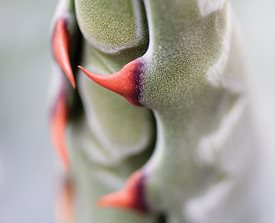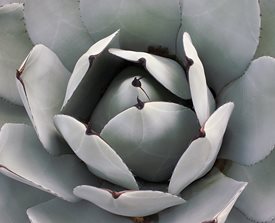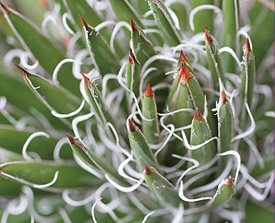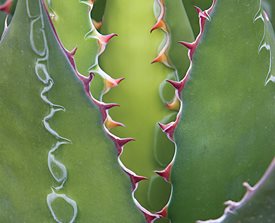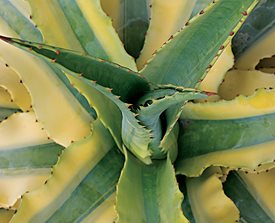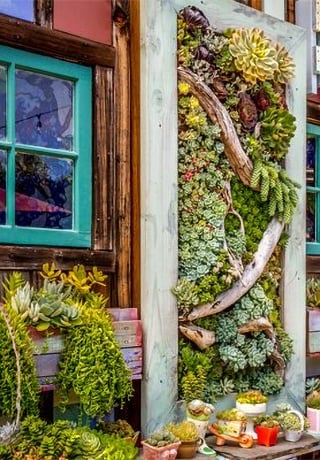Agave Plants: Care Info, Design Ideas and Varieties to Grow
Boldly architectural and wickedly beautiful, agaves combine subtle colors and in-your-face formsAgave plants offer an ideal solution for gardeners reconsidering their water-guzzling landscapes, while bringing the added benefits of drama and structure as well as texture and subtle color. Agaves grow best in the Southwest and Mediterranean climates, but are adaptable and can also be grown out of their zones in pots if given winter protection.
- Growing Agave Plants
- Agave Pros and Cons
- Agave Pictures
- Designing with Agaves
- Agave FAQS
- Agaves Indoors
GROWING AGAVE PLANTS
Why grow agave?
- Their leaf symmetry is eye-catching
- Display curious markings, wispy, curled threads or undulating striped leaves
- Among the best choices for a long-lived patio plant
- Can go without water for weeks, even months
- Are considered fire-retardant
- Locate in a spot that receives plenty of sun
- Ensure the soil is well drained
- Spring and early fall are the best times to plant
- Water once or twice a week until established
Zones:
Generally agaves thrive in the warmer subtropical zones that experience seasonal dry periods (Zones 8 to 10). A few species native to the southwest United States and northern Mexico tolerate more extreme heat and cold; Agave parryi will tolerate minus 20 degrees F (Zone 5). The best region for growing the most types is the Mediterranean climate areas of California. However, many species will thrive in the desert Southwest. In cold or wet areas elsewhere, some species can be grown if kept dry and well above zero in the winter.
Exposure:
Agaves are sun worshippers, though light shade for a couple of hours is acceptable.
Soil:
Agaves are very adaptable. Soils low in clay content are fine. Texture can be sandy or rocky. In areas with substantial rainfall, a well-drained soil is necessary.
Planting:
Plant or transplant in spring and early fall, giving larger species plenty of room to attain maximum size. Make sure that no part of the leaf rosette is covered with soil, which can cause rotting.
Watering:
Until established, water once or twice a week. Eventually, agaves prefer to dry out between each watering. Overwatering may encourage fungal root rot. In California, heavy winter rains can cause small, even medium-sized, agaves to rot.
Protection:
Protect small plants from summer sunburn and soft-leaved species from sunburn and frost with shade cloth.
AGAVE PROS AND CONS
| Pros: | Cons: |
|---|---|
|
|
AGAVE PICTURES
DESIGNING WITH AGAVES
- Agaves are great accents used with low succulent groundcovers, such as blue kleinia (Senecio mandraliscae) and sedums.
- Along with aloe and opuntia cactus, agaves add structure to a Mediterranean garden or a drought-tolerant garden, with the added benefit of being fire resistant.
- Large agaves are strong background plants, planted with smaller, slower-growing species in the foreground, but not so close to walkways that they can cause injury to passersby.
- Use one medium to large agave as a striking focal point in the ground or a container.
- Types that readily form offsets make a beautiful mass planting, useful on a steep slope where watering is difficult.
AGAVE FAQS
Is agave a cactus?
Agave is a type of succulent, commonly confused with cactus. Remember the rule that all cacti are succulents, but not all succulents are cacti. The main difference between agaves and cacti is the presence of leaves, cacti do not have them, while agaves do.
Do agaves flower?
Used primarily for their startling leaf artistry, agaves also eventually flower, though blooming signals the end of the plant’s life cycle, when they depart in a blaze of glory with a tall spike or enormous, treelike branched stalk. After the towering spires bristling with tubular blossoms are finished, the mother plant dies off. But depending on the species, new pups start to form either before or after flowering, which can be removed and put into containers of their own.
How are agaves propagated?
Pups can be pulled free from the parent plant to make more of a good thing. In addition to the progeny that sprout from the roots, some agaves make plantlets on their flower stalk. Both pups and plantlets can be removed and planted in their own pots.
AGAVES INDOORS
If you live in an area with sustained cold, bring your agaves indoors for the winter, or leave them inside year-round. Here are some tips:
- Most species require bright light to retain their unique forms-especially when kept indoors
- Stronger light is preferable or they begin to stretch and distort from the typical rosette form
- In containers, watering once a week is sufficient (agaves prefer to dry out between watering)
- Pot agaves in a homemade soil of two parts sand and one part compost
- Fertilize once a year with compost tea
Photos taken at the Ruth Bancroft Garden in Walnut Creek, California.
This article was adapted from its original version for use on the web.
RELATED:
Structural Plants & How to Use Them
Desert Plants for Arid Landscapes
Magnificent Mangave
